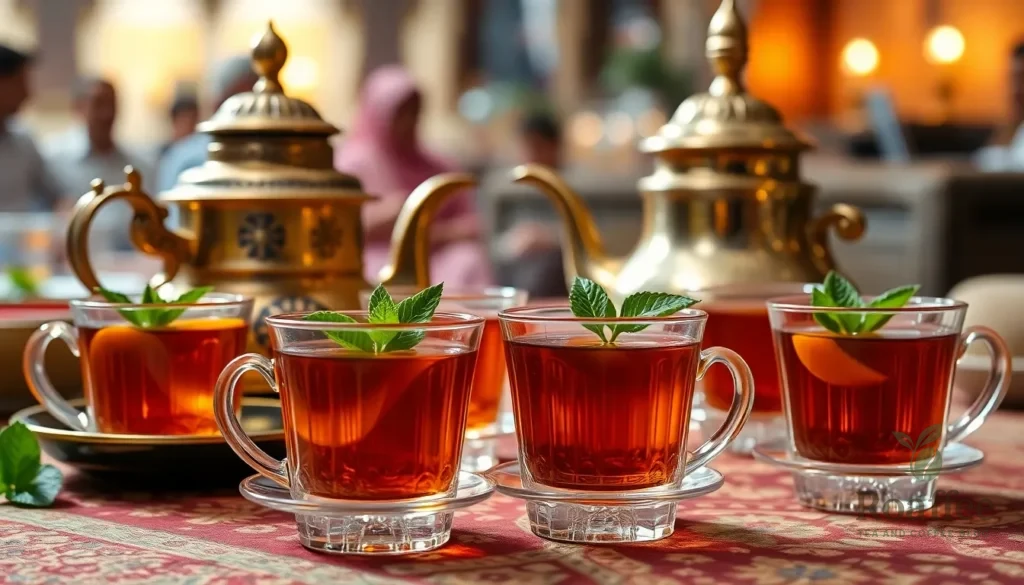We’ve discovered the perfect way to transport your taste buds straight to the bustling souks of the Middle East with this authentic Arabian tea recipe. This fragrant blend combines bold black tea with warming spices like cardamom, cinnamon, and cloves – creating a drink that’s both comforting and exotic.
Arabian tea isn’t just a beverage; it’s a cherished tradition that brings families together and welcomes guests with open arms. The aromatic steam rising from your cup carries centuries of hospitality and warmth that’ll make every sip feel like a celebration.
We’ll show you how to create this magical brew in your own kitchen using simple ingredients you can find at any grocery store. Once you master this recipe, you’ll understand why Arabian tea has been treasured across generations and why it’s become our go-to drink for special moments and everyday comfort alike.
Ingredients
We’ve carefully selected each ingredient to create the perfect balance of robust tea flavor and aromatic spices that define authentic Arabian tea. These common pantry staples combine to deliver the warm and welcoming taste that makes this Middle Eastern beverage so beloved.
For the Tea Base
- 4 cups water
- 2 tablespoons loose black tea (Ceylon or Assam preferred)
- 1/4 cup whole milk
- 2 tablespoons granulated sugar (adjust to taste)
For the Spice Blend
- 4 green cardamom pods (lightly crushed)
- 1 cinnamon stick (2-inch piece)
- 3 whole cloves
- 1/4 teaspoon ground ginger
- 1 small piece fresh ginger (1-inch, peeled and sliced)
- 1/8 teaspoon ground nutmeg
Optional Garnishes
- Fresh mint leaves
- Orange peel strips
- Crushed pistachios
- Rose petals (food-grade)
- Ground cinnamon for dusting
Equipment Needed

Brewing authentic Arabian tea requires exact equipment to achieve that perfect balance of robust flavor and aromatic spices. We recommend gathering these essential tools before beginning your tea preparation.
A tea pot or kettle forms the foundation of our brewing setup. Choose a medium-sized pot that can comfortably hold 4 to 6 cups of water while allowing room for the tea and spices to steep properly. Stainless steel or ceramic options work exceptionally well for maintaining consistent heat distribution.
Arabic tea cups elevate the traditional serving experience. These small, delicate cups typically hold 2 to 3 ounces and showcase the tea’s rich amber color beautifully. The smaller size encourages the social aspect of Arabian tea culture, where multiple servings create opportunities for conversation and connection.
A small mesh strainer proves invaluable for serving smooth, particle-free tea. This tool removes loose tea leaves, cardamom pods, and any other whole spices before pouring. Position the strainer over each cup during serving to ensure a clean, professional presentation.
Consider adding a long-handled spoon for stirring the tea and spices during brewing. This helps distribute the sugar evenly and ensures all flavors meld together harmoniously. The extended handle keeps your hands safely away from the hot pot while allowing thorough mixing.
Optional equipment includes a tea warmer or small burner for keeping your Arabian tea at the perfect serving temperature throughout your gathering. This proves especially useful when hosting guests, as it maintains the tea’s warmth without over-steeping the leaves.
Instructions
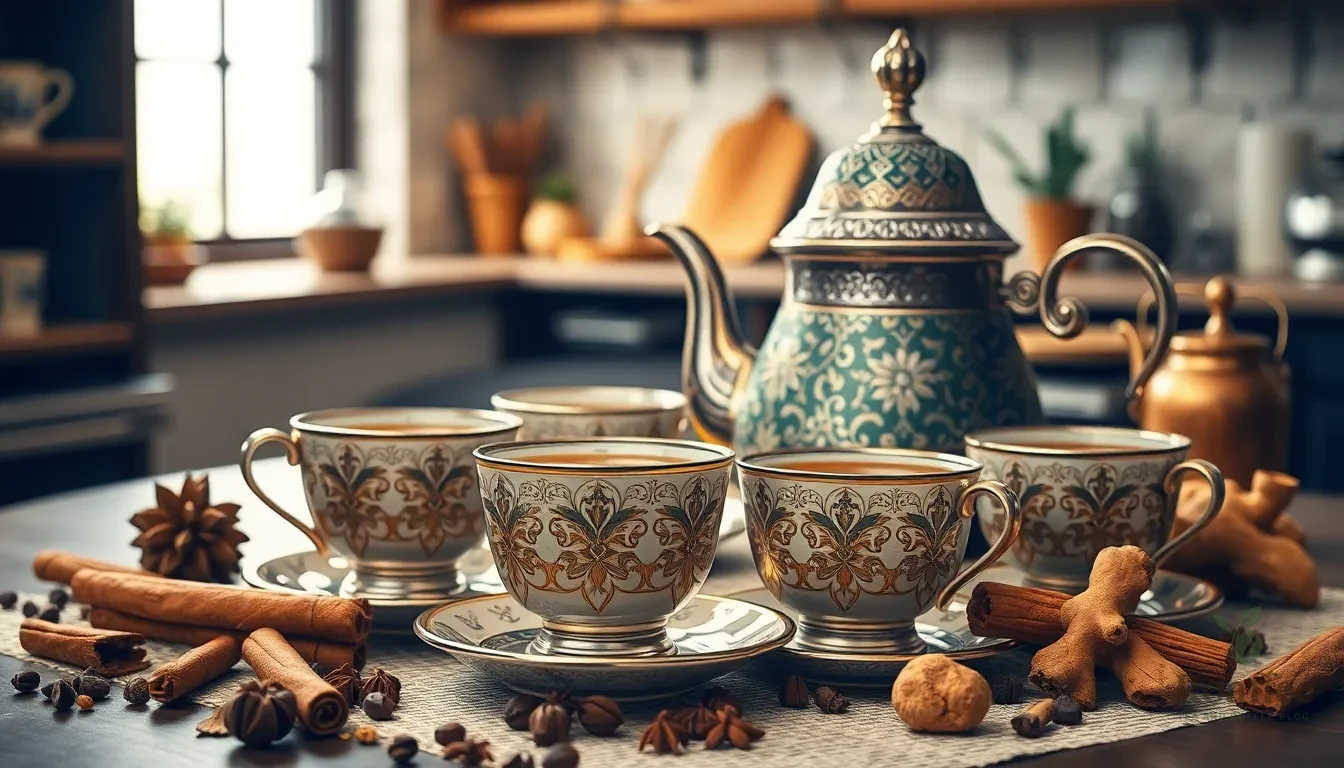
Creating authentic Arabian tea requires careful attention to each step of the brewing process. We’ll guide you through the traditional method that produces a richly spiced and aromatic tea perfect for sharing with family and friends.
Prep the Spices
We begin by preparing our aromatic spice blend that gives Arabian tea its distinctive character. Lightly crush the 6 green cardamom pods with the flat side of a knife to release their fragrant oils. Break the cinnamon stick into smaller pieces to maximize flavor extraction during steeping. Combine the crushed cardamom with 3 whole cloves and the cinnamon pieces in a small bowl.
Fresh ginger adds warmth and complexity to our tea blend. Peel and grate the 1-inch piece of fresh ginger using a fine grater. We can also use the ground ginger as a substitute if fresh isn’t available. Keep the prepared spices nearby as we’ll add them directly to our brewing vessel.
Prepare the Tea Base
We start by bringing 4 cups of water to a rolling boil in our medium-sized teapot or kettle. Once the water reaches a vigorous boil, we remove it from heat and add our 2 tablespoons of loose black tea. Ceylon or Assam varieties work exceptionally well for their robust flavor profile that stands up to the warming spices.
Dissolve 2 tablespoons of granulated sugar into the hot water while stirring gently with our long-handled spoon. The sugar should completely dissolve before we proceed to the next step. This sweetening approach ensures even distribution throughout our tea base and prevents any granular texture in the finished beverage.
Combine and Simmer
We add our prepared spice mixture to the sweetened tea base and return the vessel to medium heat. The tea should reach a gentle simmer rather than a rolling boil to prevent the spices from becoming overpowering. Allow the mixture to steep for 10-15 minutes to achieve the dark and robust brew characteristic of authentic Arabian tea.
During the steeping process, we can adjust the intensity by monitoring the color and aroma. Pour in the 1/4 cup of whole milk and add a pinch of ground nutmeg for additional complexity. We bring the tea to a brief boil once more to intensify the flavors before removing from heat. This final boiling step helps meld all the ingredients into a harmonious blend.
Strain and Serve
We carefully strain our Arabian tea through a fine mesh strainer to remove all tea leaves and whole spices. This ensures a smooth drinking experience without any unwanted particles. Pour the strained tea into our traditional Arabic tea cups while the beverage is still piping hot.
Fresh mint leaves make an excellent garnish that complements the warming spices beautifully. We can also add thin strips of orange peel or a light dusting of ground cinnamon for visual appeal. Serve immediately while the tea maintains its optimal temperature and aromatic qualities. The tea pairs wonderfully with traditional Middle Eastern sweets or can be enjoyed on its own as a comforting beverage.
Directions for Traditional Method

We begin our traditional Arabian tea preparation by bringing 4 cups of water to a rolling boil in a medium-sized pot. This foundational step ensures our tea develops the proper strength and character that defines authentic Jordanian Bedouin tea.
Next, we place 4 black tea bags directly into our teapot along with 10 cardamom pods and 1 cup of sugar. The cardamom pods should be lightly crushed to release their aromatic oils, creating the signature fragrance that makes Arabian tea so distinctive. We can substitute fresh mint leaves if cardamom is unavailable, though the traditional method favors cardamom for its warming spice notes.
We pour the boiling water over our tea mixture in the teapot, ensuring all ingredients are fully submerged. The steeping process becomes crucial here as we cover the teapot and allow the tea to steep for 10 to 15 minutes. This extended steeping time differs from conventional tea preparation and creates the deep, dark color that characterizes authentic Arabian tea.
During steeping, we monitor the tea’s color development by lifting the lid occasionally. The tea should achieve a rich, dark amber hue that signals proper extraction of flavors from both the tea leaves and spices. We continue steeping until the desired darkness is reached, as this intensity provides the robust flavor profile essential to traditional Arabian tea.
Once our tea reaches the perfect strength, we transfer the entire teapot back to the stove and bring the mixture to a second boil. This additional heating step concentrates the flavors and creates the full-bodied taste that defines Jordanian Bedouin tea tradition.
We serve our Arabian tea immediately while piping hot in small traditional cups. The generous sugar content balances the strong black tea and spices, creating a harmonious flavor profile that represents centuries of Middle Eastern tea culture. This traditional method captures the authentic taste and cultural significance of Arabian tea as enjoyed in family gatherings and social settings throughout the region.
Make-Ahead Tips
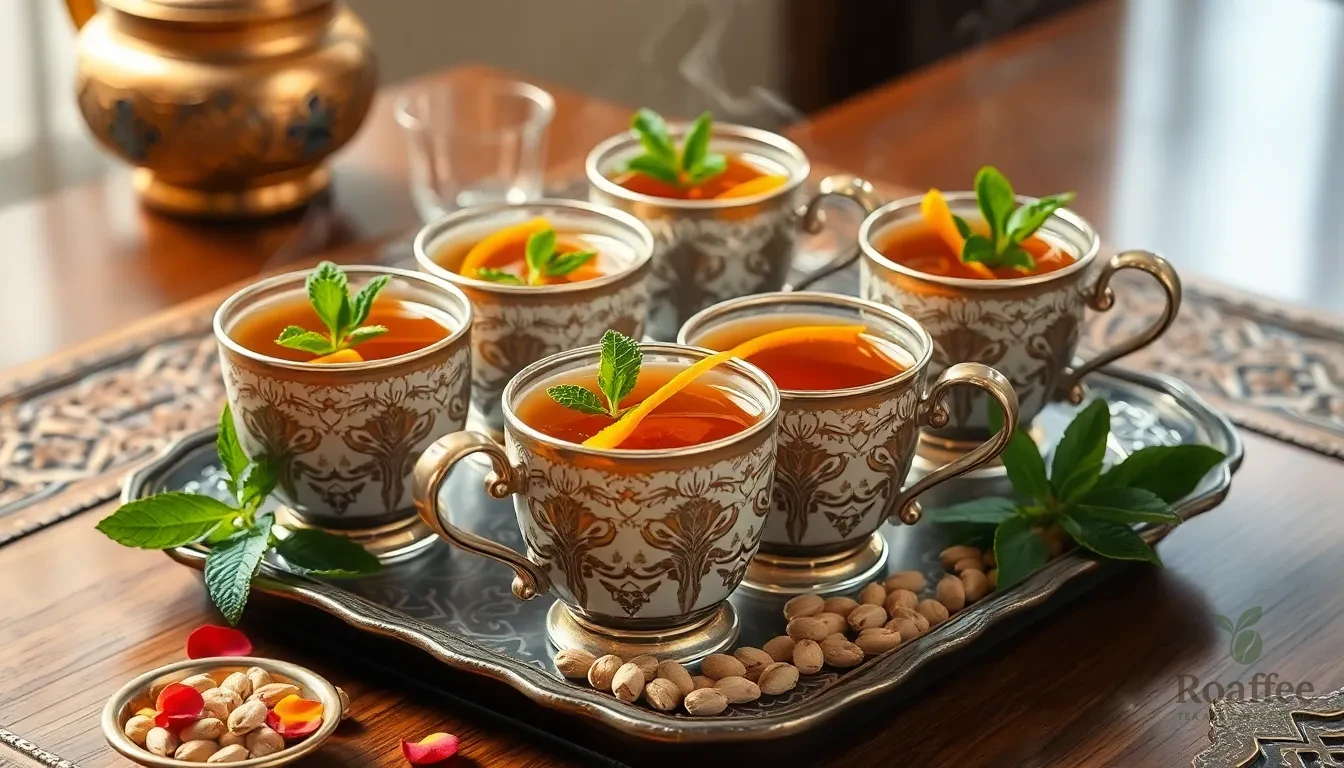
We can prepare several components of our Arabian tea recipe in advance to streamline the brewing process and ensure consistent results. The spice blend forms the foundation of our tea’s distinctive flavor profile and benefits greatly from advance preparation.
Spice Blend Preparation
Our cardamom pods can be lightly crushed and stored in an airtight container up to 2 weeks before use. We recommend crushing 20-30 cardamom pods at once and storing them in small portions for multiple tea sessions. The cinnamon sticks break more easily when stored at room temperature and can be prepared 3-4 days ahead.
Tea Base Components
We can pre-measure our loose black tea portions into individual containers or tea bags for convenient brewing. This method works particularly well when hosting gatherings where multiple batches may be needed. Sugar portions can be measured and stored in small containers alongside the tea portions.
Concentrate Method
Our Arabian tea concentrate offers the most efficient make-ahead approach. We brew a double-strength version using 4 tablespoons of loose black tea and our full spice blend in 2 cups of water. This concentrate keeps refrigerated for up to 3 days and can be diluted with hot water and milk when ready to serve.
Garnish Preparation
Fresh mint leaves stay vibrant when stored between damp paper towels in the refrigerator for up to 5 days. We can prepare orange peel strips by carefully removing the bitter white pith and storing the strips in an airtight container for up to 1 week. Crushed pistachios and rose petals maintain their quality when stored in sealed containers at room temperature.
Serving Equipment
We recommend warming our traditional Arabic tea cups before serving by rinsing them with hot water. This simple step can be done while the tea steeps and ensures our tea maintains its optimal temperature longer.
Serving Suggestions
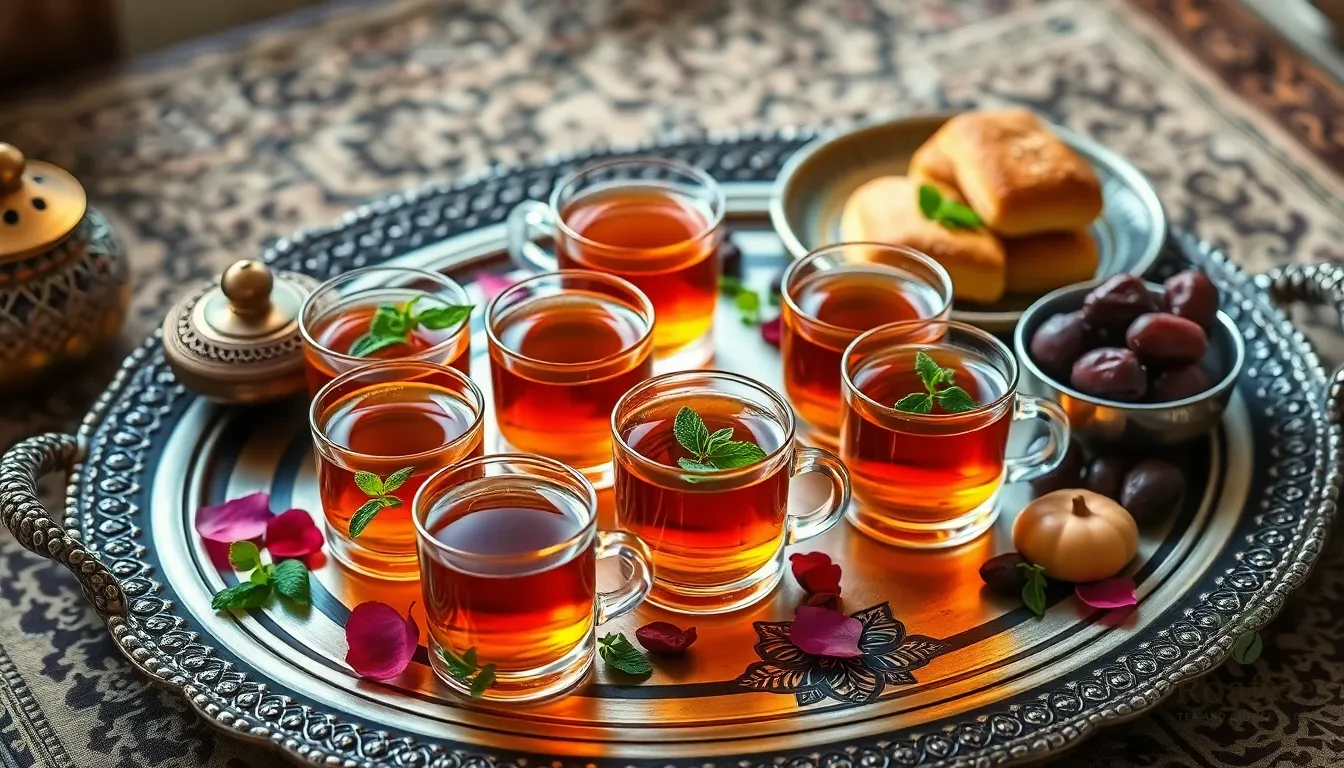
Arabian tea shines brightest when served in small traditional glass or porcelain cups that showcase its rich amber color. We recommend using authentic Arabic tea cups that hold approximately 3-4 ounces to maintain the traditional serving size and allow guests to savor multiple cups during social gatherings.
Temperature plays a crucial role in the Arabian tea experience. Serve the tea immediately while it’s steaming hot to preserve the aromatic oils from the spices and maintain the perfect balance of flavors. The warmth enhances the cardamom and cinnamon notes while allowing the sweetness to bloom on the palate.
Traditional Accompaniments
Arabian tea pairs beautifully with Middle Eastern sweets and snacks that complement its bold flavor profile. Fresh dates provide a natural sweetness that balances the tea’s robust character while adding authentic cultural appeal. Honey-soaked pastries like baklava or ma’amoul cookies create a delightful contrast to the tea’s spiced notes.
For a lighter accompaniment, we suggest serving the tea alongside simple butter cookies or shortbread that won’t compete with the complex spice blend. Dried fruits such as figs or apricots offer a chewy texture that enhances the overall tasting experience.
Cultural Presentation
Position the tea service as the centerpiece of your gathering to honor Arabian hospitality traditions. Present the tea on ornate serving trays with matching sugar bowls and small spoons for guests who prefer additional sweetening. Fresh mint sprigs or rose petals scattered around the cups add visual appeal and subtle fragrance.
Consider offering the tea in multiple rounds throughout your gathering, as is customary in many Middle Eastern cultures. This approach allows guests to enjoy the tea’s evolving flavors and creates natural conversation breaks during social events.
Flavor Enhancement Options
Lemon wedges provide a citrusy twist that brightens the tea’s deep flavors while adding vitamin C benefits. Some guests may prefer a touch of honey instead of the traditional sugar, which adds floral notes that complement the spice blend perfectly.
For those seeking variety, offer both the traditional cardamom version and the fresh mint variation side by side. This presentation allows guests to experience different regional interpretations of Arabian tea while discovering their personal preferences.
Storage Instructions
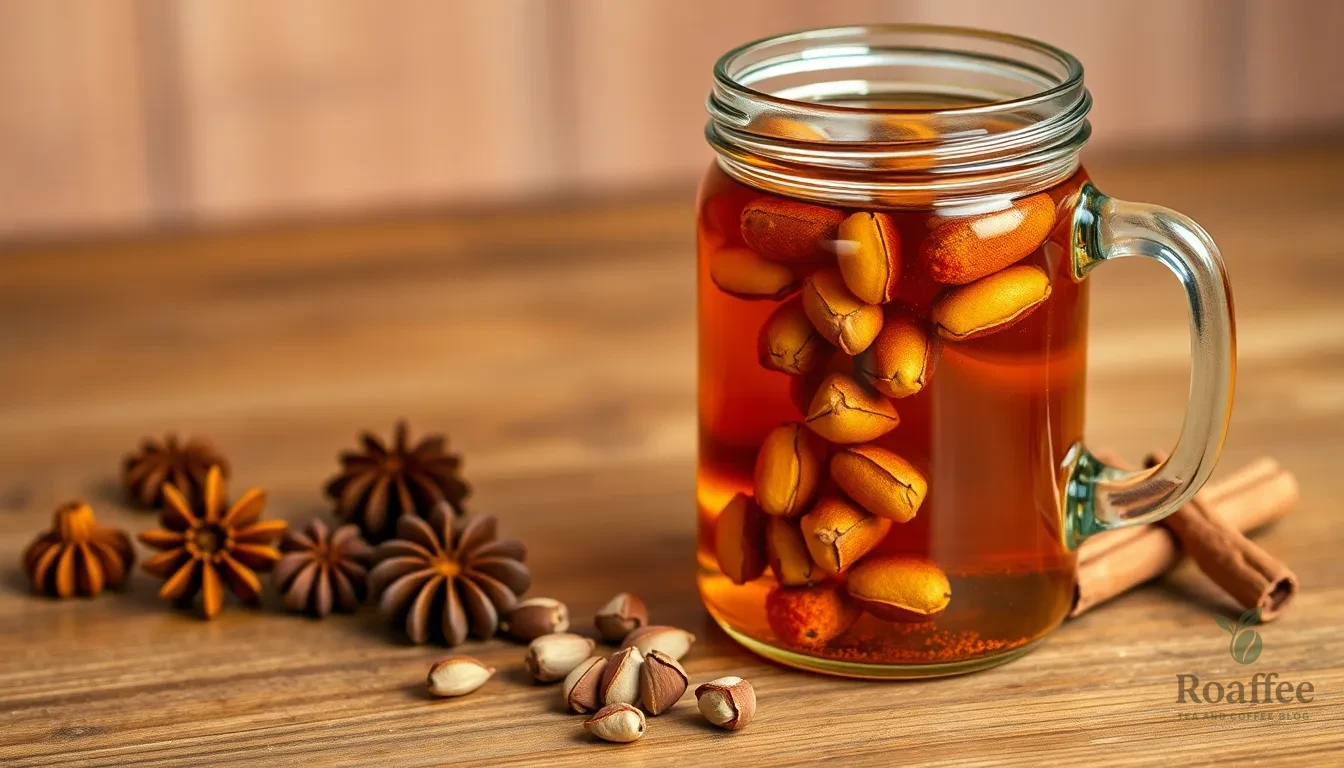
Arabian tea achieves its best flavor when prepared fresh and served immediately. We recommend brewing only what you plan to consume within a few hours to maintain the vibrant spice notes and rich amber color that define authentic Arabian tea.
When storing leftover tea, we suggest transferring it to a clean glass jar or airtight container. The tea will maintain its quality in the refrigerator for up to 3 days. Remove the tea bags or strain out loose tea leaves before refrigerating to prevent over-extraction and bitterness.
For our concentrated chai version with spices, we cool the mixture completely before straining through a fine mesh strainer. This concentrate stores exceptionally well in the refrigerator for up to one week. When ready to serve, we dilute it with hot water or warm milk to achieve the desired strength.
Our spice blend ingredients require separate storage considerations for maximum freshness. We store crushed cardamom pods in an airtight container at room temperature for up to 6 months. Whole cinnamon sticks maintain their potency for up to one year when stored in a cool, dry place away from direct sunlight.
Pre-measured sugar and loose black tea can be stored together in sealed containers for convenient future brewing. We label these containers with preparation dates to track freshness. The tea mixture maintains optimal flavor for up to 6 months when stored properly.
Fresh garnishes like mint leaves require immediate use or proper refrigeration. We wrap fresh mint in damp paper towels and store it in the refrigerator for up to one week. Orange peel strips can be dried and stored in airtight containers for several months as a convenient garnish option.
We never recommend reheating Arabian tea multiple times as this compromises both flavor and aroma. Instead, we prepare smaller batches or use the concentrate method for serving flexibility during extended gatherings.
Variations
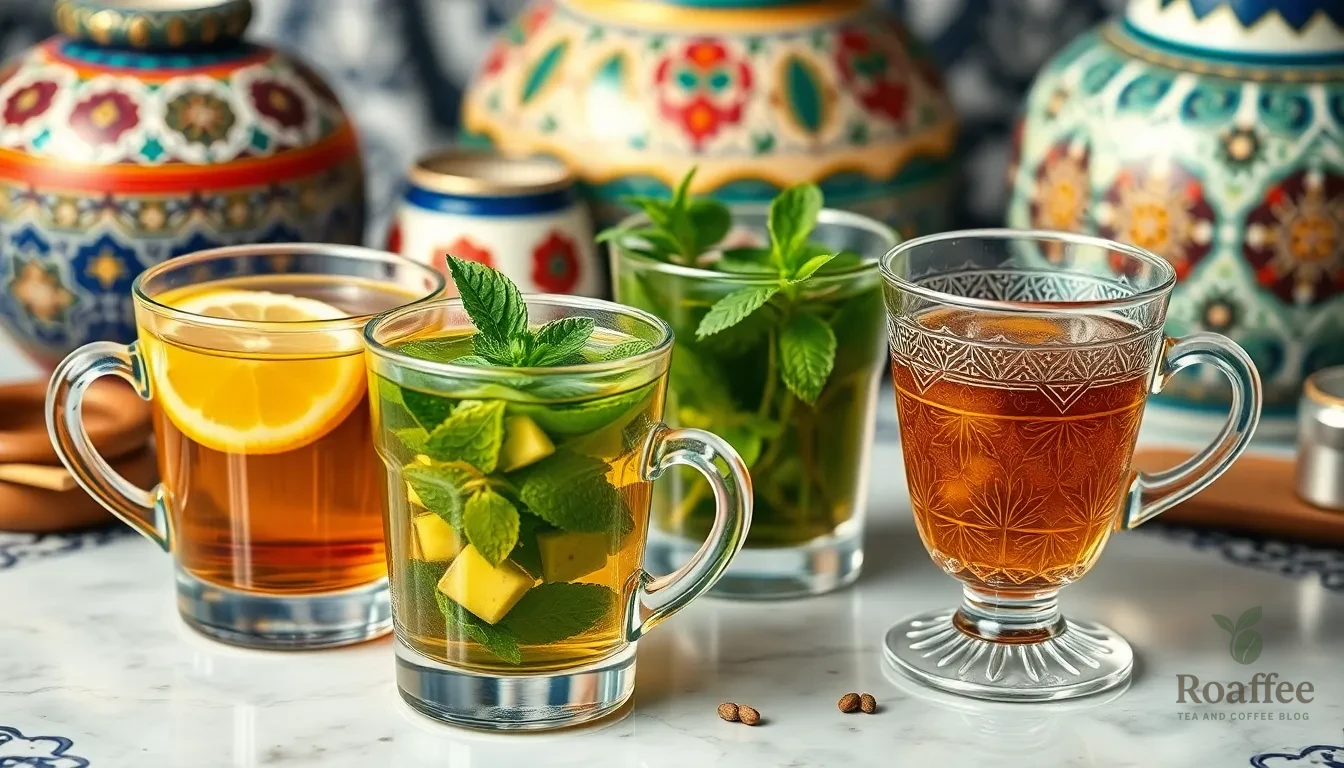
Arabian tea traditions offer several distinct regional variations that reflect local tastes and cultural preferences. Each variation maintains the foundation of strong black tea while incorporating unique flavor profiles and preparation methods.
Sweet Arabian Tea
We find this variation particularly popular in Saudi Arabia where sweetness takes center stage. This version uses approximately 1/4 cup of granulated sugar per 4 1/2 cups of water, creating an intensely sweet beverage that reflects traditional Saudi tea preferences. We add the sugar directly to the boiling water along with black tea bags or loose black tea, allowing them to brew together for 3 minutes. Fresh mint leaves can be included during the boiling process for added complexity. Some regions enhance this sweet base with a splash of fresh lemon juice, creating a bright citrus note that balances the heavy sweetness. The result is a robust, very sweet tea that serves as both refreshment and dessert in one cup.
Mint Arabian Tea
Known as Shai Bil Na’ana’a, this refreshing variation highlights the cooling properties of fresh mint leaves. We begin by boiling water and adding black loose-leaf tea, allowing it to boil for exactly 1 minute before removing from heat. Fresh mint leaves are then added to the hot tea, and we cover the pot to steep for 5 minutes until the liquid reaches a beautiful amber red color. The mint should be added after removing from heat to preserve its delicate oils and prevent bitterness. We serve this variation in clear tea cups to showcase the stunning amber color, with sugar offered on the side so each person can adjust sweetness to their preference. Using purified water enhances the clarity of both the tea and mint flavors, creating a more refined taste experience.
Cardamom-Heavy Version
This aromatic variation, often called Karak Tea or Karak Chai, represents the spice-forward approach favored throughout the Gulf states. We use green cardamom pods as the primary spice, often accompanied by whole cloves, cinnamon sticks, and sometimes fresh ginger, nutmeg, or saffron for added complexity. The preparation involves brewing strong black tea with the spices, then incorporating milk (often evaporated unsweetened milk) and sugar to create a creamy, richly spiced beverage. We crush the cardamom pods lightly before adding them to release their essential oils, and the entire mixture simmers together to develop deep, warming flavors. This variation is particularly popular in the UAE and Saudi Arabia, where the combination of milk and aromatic spices creates a comforting drink with a distinctly Middle Eastern character.
| Variation | Key Ingredients | Flavor Profile | Regional Preference |
|---|---|---|---|
| Sweet Arabian Tea | Black tea, heavy sugar (1/4 cup per 4.5 cups water), optional mint and lemon | Very sweet, sometimes citrusy | Saudi Arabia |
| Mint Arabian Tea | Black tea, fresh mint leaves, optional sugar | Refreshing, herbal, mildly sweet | Widely popular across Arab regions |
| Cardamom-Heavy Version | Black tea, cardamom pods, cloves, milk, sugar, optional spices | Rich, creamy, aromatic, spiced | Gulf states (UAE, Saudi Arabia) |
Conclusion
We’ve shared everything you need to create authentic Arabian tea that’ll transport your taste buds straight to the Middle East. This isn’t just another beverage recipe – it’s your gateway to experiencing centuries of hospitality tradition right from your own kitchen.
The beauty of Arabian tea lies in its versatility. Whether you prefer the sugar-forward Saudi style or the refreshing mint variation we’ve covered it all. You can easily adapt these recipes to match your taste preferences while staying true to the authentic brewing methods.
Remember that the key to exceptional Arabian tea is patience during the steeping process and quality ingredients. With our make-ahead tips and storage guidelines you’ll be ready to serve this aromatic masterpiece whenever guests arrive.
Now it’s time to gather your spices warm those traditional cups and create your own Arabian tea experience. We’re confident you’ll love this timeless recipe as much as we do.
Frequently Asked Questions
What is Arabian tea and what makes it special?
Arabian tea is a traditional Middle Eastern beverage made with bold black tea and warming spices like cardamom, cinnamon, and cloves. It’s more than just a drink – it’s a symbol of hospitality and family togetherness, cherished for both special occasions and everyday enjoyment.
What ingredients do I need to make authentic Arabian tea?
You’ll need 4 cups water, 2 tablespoons loose black tea (Ceylon or Assam), 1/4 cup whole milk, 2 tablespoons sugar, green cardamom pods, cinnamon stick, whole cloves, ground ginger, fresh ginger, and ground nutmeg. Optional garnishes include fresh mint, orange peel, and crushed pistachios.
How long should I steep Arabian tea?
Steep Arabian tea for 10-15 minutes to achieve the characteristic rich, dark amber color and robust flavor. This extended steeping time is crucial for developing the authentic taste of traditional Jordanian Bedouin tea.
Can I make Arabian tea ahead of time?
Yes! You can prepare the spice blend in advance, pre-measure ingredients, and even make a double-strength concentrate that can be refrigerated and diluted when ready to serve. Fresh tea is best consumed within a few hours.
What are the different regional variations of Arabian tea?
Popular variations include Sweet Arabian Tea (heavy sugar content), Mint Arabian Tea (Shai Bil Na’ana’a with fresh mint), and Cardamom-Heavy Version (Karak Tea with milk and spices). Each maintains the strong black tea foundation while offering unique flavor profiles.
How should I serve Arabian tea traditionally?
Serve Arabian tea hot in small traditional cups to showcase its rich amber color. Accompany with fresh dates, honey-soaked pastries, or butter cookies. The tea service should be a centerpiece of gatherings, reflecting Middle Eastern hospitality traditions.
How do I store leftover Arabian tea?
Store leftover tea in a glass jar or airtight container in the refrigerator for up to 3 days. Concentrated versions can last up to a week. Avoid reheating multiple times to maintain quality – consider making smaller batches instead.

